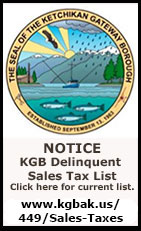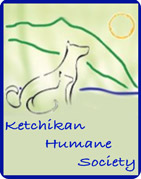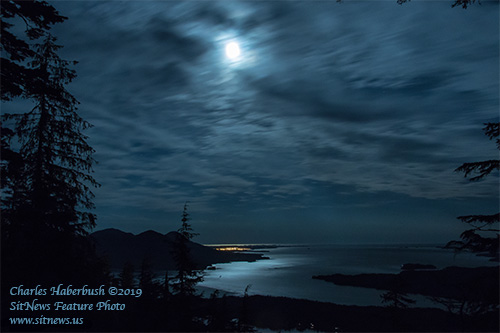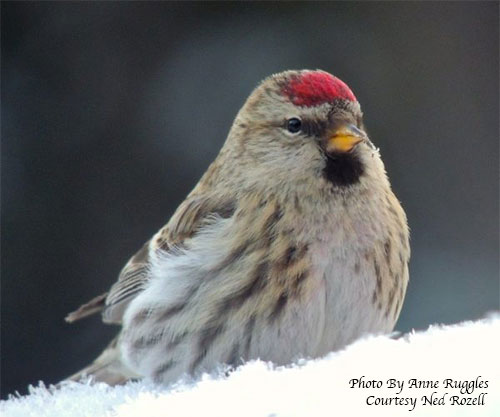






Weekly Specials
Online Shopping; Pickup or Delivery |
|













 Contact Contact 
 Webmail
Letters Webmail
Letters
 News Tips News Tips
 Copyright Info Copyright Info
 Archives Archives
Quick News
Search
 Alaska Alaska
 Ketchikan Ketchikan
 SE Alaska SE Alaska
Columns
- Articles
 Dave Kiffer Dave Kiffer
 Money Matters Money Matters
Historical
Ketchikan
 June Allen June Allen
 Dave
Kiffer Dave
Kiffer
 Louise
B. Harrington Louise
B. Harrington
Sports
 Ketchikan Links Ketchikan Links
Public Records
 FAA Accident Reports FAA Accident Reports
 NTSB
Accident Reports NTSB
Accident Reports
 Court Calendar Court Calendar
 Recent Filings & Case Dispositions Recent Filings & Case Dispositions
 Court Records Search Court Records Search
 Sex Offender Reg. Sex Offender Reg.
 Public Notices Public Notices
 Alaska Recall Alerts Alaska Recall Alerts
 Recalls.gov Recalls.gov
 AST Daily Dispatch AST Daily Dispatch
 KTN
Police Reports KTN
Police Reports
 Juneau Police Reports Juneau Police Reports
Weather,
Webcams
 Today's
Forecast Today's
Forecast
 KTN
Weather Data KTN
Weather Data
 AK
Weather Map AK
Weather Map
 AK Weathercams AK Weathercams
 AK Earthquakes AK Earthquakes

|
|

Monday
February 04, 2019

Lights of Metlakatla
The distant lights of Metlakatla were photographed from one mile up on Ketchikan's Deer Mountain Trail.
Front Page Feature Photo By CHARLES HABERBUSH ©2019
|
|
Alaska: United States and Canada Reach New Agreement on Coast Wide Pacific Halibut Quota - Chris Oliver, Administrator for NOAA Fisheries and U.S. Commissioner to the International Pacific Halibut Commission, announced today the United States and Canada reached a new agreement on a coast wide Pacific halibut quota on Feb. 1, 2019 at the International Pacific Halibut Commission meeting in Victoria, Canada.
The 95th Session of the International Pacific Halibut Commission (IPHC) Annual Meeting was held in Victoria from January 28, 2019 to February 01,2019. A total of 16 (21 in 2018) members (6 Commissioners; 10 advisors/experts) attended the Session from the two (2) Contracting Parties, as well as 182 (199 in 2018) members of the public in person and 142 (99 in 2018) via the webcast (total of 340 meeting participants). The meeting was opened by the Chairperson, Paul Ryall (Canada) and Vice-Chairperson, Chris Olivier (U.S.A.), who welcomed participants to Victoria, Canada.
According to today's statement released by Oliver, the new quota of 38.61 million pounds reflects an increase of 1.4 million pounds above the 2018 quota. Based on input from stakeholders and analysis from Commission science reports, the United States and Canada agreed to a rebalancing of the coast wide quota resulting in Canada receiving a 17.7% share and the U.S. receiving an 82.3% share.
The International Pacific Halibut Commission (IPHC) also agreed to a 1.65 million pound allocation for the U.S. West Coast (Area 2A) to address tribal, recreational, and commercial needs in that area, announced Oliver.
According to Oliver's statement, the IPHC intends to apply the allocation process developed at this meeting over the next four years, pending any unanticipated conservation or management concerns.
"While the overall quota for 2019 is a slight increase over 2018, the catch limits agreed to at the meeting reflect a sensible, conservative approach that will secure the future of this iconic and economically important species. We solved several challenging international fishery management issues and we accomplished our goal in the spirit of cooperation and compromise. We look forward to working closely with our partners at future meetings." stated Oliver. - More...
Monday PM - February 04, 2019
Fish Factor:
2019 Commercial Catches of Pacific Halibut Increased
By LAINE WELCH
- Contrary to all expectations, commercial catches of Pacific halibut were increased for 2019 in all but one Alaska region.
The numbers were revealed Friday at the International Pacific Halibut Commission annual meeting in Victoria, British Columbia.
The reason was due to increased estimates of the overall halibut biomass based on expanded surveys last summer from Northern California to the Bering Sea, said Doug Bowen who operates Alaska Boats and Permits in Homer.
“There’s a couple of strong year classes from 2011 and 2012 that are just starting to show up in the commercial catches and I think the scientists are cautiously optimistic that we could see some better harvests as a result of those halibut entering the fishery,” he said in a phone call as he was leaving the meetings.
The coastwide commercial catches were increased to nearly 25 million pounds, almost six percent higher than 2018. Alaska’s share will be just under 20 million pounds, a boost of about three million pounds.
Southeast Alaska’s catch was upped by just over 1 percent to 3.6 million pounds; the Central Gulf gets a nearly 10 percent increase to over 8 million pounds.
The Western Gulf is the only Alaska region to get a halibut reduction – a catch of 2.3 million pounds is a drop of more than 11 percent.
Halibut harvests at the two Aleutian Islands regions were increased to well over one million pounds and the Bering Sea catches went up by nearly 30 percent to top 2 million pounds.
Bowen said the increases came despite concerns by IPHC executive director, Dr. David Wilson.
“He feels that any coastwide catches over 20 million pounds will result in declines in the biomass. So, it is interesting that the catch limits are going up in light of the fact that we do have both declining recruitment and harvest rates coastwide,” Bowen said.
The halibut fishery will open on March 15 and run through November 14, said Malcolm Milne, president of the Kenai Peninsula Fishermen’s Association. And in more good news for Alaska, Milne added that next year’s IPHC annual meeting will be held in Anchorage. - More...
Monday PM - February 04, 2019
|
Southeast Alaska: SHI Condemns FaceBook Ban on Sale of Products with Animal Parts, Fur - Sealaska Heritage Institute (SHI) is condemning a Facebook ban on legal sales of products made from any "part, pelt or skin from an animal, including fur," according to the site's commerce policy.
The ban will have a devastating effect on Native artists throughout the state, who sell through Facebook and are dependent on the proceeds from arts and handicraft made from animal parts for their basic livelihood, said SHI President Rosita Worl.
"It runs counter to SHI's efforts to establish sustainable arts-and-craft economies in rural communities where opportunities to earn a cash income are limited or non-existent," said Worl, who noted support for a sustainable sea otter harvest and sale of handicrafts is also a priority of the Alaska Chamber of Commerce.
SHI became aware of the ban after Sitka skin sewer Robert Miller posted a sea otter hat for sale on Facebook and received a message last week saying it was not approved because it didn't meet Facebook's commerce policies. The artist then contacted Sealaska Heritage.
"This fur was harvested legally under the federal Marine Mammal Protection Act and this art practice has been part of our indigenous culture for more than 10,000 years," Miller said. "I don't understand why Facebook has put this ban in place."
Worl has reached out to Alaska's Congressional delegation to help advocate for a remedy to the issue.
Today, U.S. Senator Dan Sullivan (R-AK)wrote the CEO of Facebook, Mark Zuckerberg, to clarify Facebook Marketplace’s policies regarding the sale of products or artwork made with any “part, pelt or skin from an animal, including fur.”
Late last week, Senator Sullivan was made aware of the policy issue by the Sealaska Heritage Institute – which informed the Senator that Sitka skin sewer Robert Miller posted a sea otter hat for sale on Facebook and received a message saying it was not approved because it didn’t meet Facebook’s commerce policies.
According to Sen. Sullivan's news release today, Facebook has since indicated the removal of these ads was a mistake. However, Senator Sullivan is requesting greater clarity on the scope of prohibited items for Alaska Native craftsmen and their customers around the world.
“The Alaska Native community has for thousands of years used animal products for survival, subsistence, and as a key means of cultural expression,” Senator Sullivan wrote. “Inhibiting the sale of these items not only limits the cultural exchange Facebook has empowered the Alaska Native community to share, but also threatens one of the key economic opportunities in remote Alaska villages.
Sullivan said, “Going forward, I hope we can work together to positively use the power of Facebook to the benefit of Alaska Native people and their communities. An important part of my work in the Senate is to try to correct the problems caused when public officials and entities like online vendors do not fully understand the unique circumstances of my constituents.”
"The sale of Native arts and handicraft arises from ancient traditions and has been a cornerstone of Native culture and societies for thousands of years," said U.S. Senator Dan Sullivan. "Facebook has connected the world, and in particular remote Alaska communities and Alaska Native cultures. Unfortunately, Facebook's ban, without recognizing or accommodating the legal right of Alaska Natives to produce and sell handicrafts, threatens to reduce the site's positive impacts for the Alaska Native community. I would urge Mr. Zuckerberg to draw on his experiences traveling in our great State and his respect for our Native organizations, and amend Facebook's policy to account for Alaska Natives' traditions and legal rights."
Sealaska Heritage Institute also contacted Zuckerberg through his Facebook account, asking him to at least consider allowing an exemption for Alaska Native and Indigenous peoples. - More...
Monday PM - February 04, 2019
Arctic: Northern Magnetic Model Out-of-Cycle - Earth’s northern magnetic pole is moving quickly away from the Canadian Arctic toward Siberia. This movement has forced NCEI’s scientists to update the World Magnetic Model (WMM) mid-cycle.
Typically, a new and updated version of the WMM is released every five years. With the last release in 2015, the next version is scheduled for release at the end of 2019. Due to unplanned variations in the Arctic region, scientists have released a new model to more accurately represent the change of the magnetic field between 2015 and now.
This out-of-cycle update before next year’s official release of WMM2020 will ensure safe navigation for military applications, commercial airlines, search and rescue operations, and others operating around the North Pole.
Uses of the World Magnetic Model
Organizations, such as NASA, the Federal Aviation Administration, U.S. Forest Service, and many more use this technologyThe military uses the WMM for undersea and aircraft navigation, parachute deployment, and more. Other governmental organizations, such as NASA, the Federal Aviation Administration, U.S. Forest Service, and many more use this technology for surveying and mapping, satellite/antenna tracking, and air traffic management.
Smartphone and consumer electronics companies also rely on the WMM to provide consumers with accurate compass apps, maps, and GPS services. - More...
Monday PM - February 04, 2019 |

Invasion of redpolls sends seeds flying
A common redpoll pauses on a winter day in Fairbanks.
Photo By Anne Ruggles |
|
Alaska Science: Invasion of redpolls sends seeds flying By NED ROZELL - Why, a friend asked, are there so many birch seeds on top of the snowpack in Fairbanks? A day later, the answer hit me in the head.
As I walked through the forest, I looked up just in time to get peppered with frozen specks from above. Redpolls, finches that fit in the palm of your hand, were in a birch tree overhead, hammering at clumps of seeds clinging to otherwise naked branches.
A rain of seeds came wafting down, slowed by their oval wings. On the snow, redpolls pecked at the seeds, each shaped like a pumpkinseed but not much larger than a period.
Those tiny seeds are one of the best available energy sources for redpolls, which often spend the entire year in Alaska but have been known to show up en masse farther south.
During “irruptions,” birders in New England can suddenly find their feeders clogged with redpolls from Canada and Alaska. People in the Lower 48 documented winter irruptions (“to increase rapidly or irregularly in number,” according to the American Heritage College Dictionary) of redpolls during 2008-2009 and 2012-2013.
The birds are hit and miss here in Alaska. In Anchorage, Christmas bird-counters saw 8,000 redpolls in 2004. A year later, they counted 500.
Trudy Cook in the Ninilchik/Anchor Point area on the Kenai Peninsula said she has not had redpolls at her feeder for the last three years. After a long absence, the birds suddenly appeared at Anne Ruggles’ Fairbanks home in early November 2018.
“This year the birch have really produced a lot of seeds,” said Ruggles, former director of the Alaska Bird Observatory. “It’s easy to tell where the (redpolls) are feeding along the ski trails because there is a blanket of birch seeds on the trail, sometimes enough to cause you to lose glide.” - More...
Monday PM - February 04, 2019
|
Analysis: Measles: Why it's so deadly, and why vaccination is so vital By PAUL DUPREX - On the darkest day of 2018, the winter solstice, we at the Center for Vaccine Research at the University of Pittsburgh tweeted, with despair, a report in the Guardian that measles cases in Europe reached the highest number in 20 years.
The State of Alaska recently released an alert about the measles outbreak in Washington State as many Alaskans travel to that state.
On Jan. 25, 2019 the Governor of Washington declared an emergency in all counties after more than two dozen measles cases were confirmed in the state since Jan. 1, 2019. |
Why was this a cause for concern? Europe is far away from the United States, and as some people apparently believe measles is a benign, childhood disease that causes a bit of a rash, a dribbling nose and a few spots, right? What was all the fuss about?
Well as George Santayana said, “Those who cannot remember the past are condemned to repeat it.” Collective amnesia about the virulence of this disease has driven us to forget that measles virus has killed tens of millions of infants throughout history. Now, with several ongoing outbreaks across our own country, this unnecessary threat is back.
Measles is a highly contagious and sometimes deadly disease that spreads like wildfire in naive populations. The virus played its part in decimating Native American populations during the age of discovery. Since these people groups had no natural immunity to the diseases brought to the New World by Europeans, some estimates suggest up to 95 percent of the Native American population died due to smallpox, measles and other infectious diseases.
In the 1960s, measles infected about 3-4 million people in the U.S. each year. More than 48,000 people were hospitalized, and about 4,000 developed acute encephalitis, a life-threatening condition in which brain tissues become inflamed. Up to 500 people died, mainly from complications such as pneumonia and encephalitis. This was why vaccine pioneers John Enders and Thomas Peebles were motivated to isolate, weaken and develop a vaccine against measles that is truly transformative for human health. Parents who knew the reality of the disease were quick to vaccinate their children. Uptake skyrocketed and the number of cases, and associated deaths, plummeted in the developed world. - More...
Monday PM - February 02, 2019
Analysis: Why losing a dog can be harder than losing a relative or friend By FRANK T. McANDREW - Recently, my wife and I went through one of the more excruciating experiences of our lives – the euthanasia of our beloved dog, Murphy. I remember making eye contact with Murphy moments before she took her last breath – she flashed me a look that was an endearing blend of confusion and the reassurance that everyone was ok because we were both by her side.
When people who have never had a dog see their dog-owning friends mourn the loss of a pet, they probably think it’s all a bit of an overreaction; after all, it’s “just a dog.”
However, those who have loved a dog know the truth: Your own pet is never “just a dog.”
Many times, I’ve had friends guiltily confide to me that they grieved more over the loss of a dog than over the loss of friends or relatives. Research has confirmed that for most people, the loss of a dog is, in almost every way, comparable to the loss of a human loved one. Unfortunately, there’s little in our cultural playbook – no grief rituals, no obituary in the local newspaper, no religious service – to help us get through the loss of a pet, which can make us feel more than a bit embarrassed to show too much public grief over our dead dogs.
Perhaps if people realized just how strong and intense the bond is between people and their dogs, such grief would become more widely accepted. This would greatly help dog owners to integrate the death into their lives and help them move forward. - More...
Monday PM - February 02, 2019
|
|
Money Matters: WHAT HAVE YOU LEARNED FROM THIS STOCK MARKET CORRECTION? By MARY LYNNE DAHL, CFP® - The stock market has challenged a lot of people’s patience. Many people have had enough of the volatility and uncertainty of stock prices and have gotten out entirely. Many of these people will never get back in, and that is unfortunate. Although it is totally understandable that the market is frustrating and perhaps scary to some, getting out during a correction is absolutely the wrong thing to do. I will illustrate why shortly, so keep reading, please.
While some people have gotten out of the stock market lately, many others have stayed the course and have either done little or nothing to their portfolios or they have added cash to their portfolios. These are the smart investors. They will accumulate more wealth than those people who have gotten out. And although accumulating more wealth does not mean to “get rich”, it does mean to become more secure financially. This security is generally the goal of typical investors, so working to achieve it is important. The word “wealth” is not a measure of great riches; it is, rather, a measure of achieving the important goal of being as secure as reasonably possible.
With that in mind, why is getting out the wrong move to make when the market falls, as it has done recently (more than once). And why is it smart that some investors have added cash and invested even more money during all of this chaos? - More...
Monday PM - February 04, 2019
|

Political Cartoon: Politicans & Yearbooks
By Fitzsimmons ©2019, The Arizona Daily Star
Distributed to subscribers for publication by Cagle Cartoons, Inc.
|
Trump Is A National Security Threat By
Donald Moskowitz - As a former Navy enlisted man and an officer I am concerned with the threat to national security posed by President Trump. His attacks on our intelligence agencies and cozy relationship with Vladimir Putin are un-American.
Recently Trump dismissed the input of his intelligence chiefs about the threats posed by Russia, China, North Korea, Iran and ISIS. Trump continues to question the assessment of our intelligence agencies that Russia meddled in the 2016 election. Trump is in an ongoing trade war with China which is adversely impacting the global and U.S. economies. He erroneously believes North Korea is not a nuclear threat to the U.S.. And he is pulling our military out of Syria, which will allow ISIS to reconstitute itself and allow Turkey to attack our allies, the Kurds. - More...
Monday PM - February 04, 2019
 |
Why Drug Prices Keep Going Up - and Why They Need to Come Down By
Alex M. Azar II - Two years ago this month, President Trump promised the American people that he would stop drug companies from “getting away with murder” with their annual ritual of price increases. Since then, his historic actions on drug pricing have produced historic results. One official measure of drug price inflation was actually negative in 2018, for the first time in almost 50 years.
But many problems remain. This January, drug companies once again announced large price increases — by one analysis averaging around 6 percent per drug. This annual practice of large price hikes must stop, and prices must come down. - More...
Thursday PM - January 31, 2019
Big or small, radiation can affect your health By
Art Nash and Jennifer Athey - Certain words can create anxiety depending on your life experiences. One of those words is radiation. This is especially true for those of us who grew up during the Cold War and had under-the-desk drills, saw yellow rectangle “Fallout Shelter” signs at school and came to know geography framed by Hiroshima, Nagasaki, Three-Mile Island and Chernobyl.- More...
Saturday PM - January 26, 2019
 |
Re: Edwards' Mess By
Gigi Pilcher - I agree 100% with John Herrington's Letter regarding prosecution of each and every adult employed by the KGDSB who knew (first hand) about the sexual assault/sexual abuse allegation. - More...
Friday PM - January 18, 2019
Vote for Donna Frank By
Kathleen Yarr - I have known Donna Frank since 1987. I hired her to work on the KIC Welfare Reform program in 1994 when I was the Director of Social Services.
- More...
Friday PM - January 18, 2019
The Edwards' Mess By
John Harrington - The Ketchikan School Board investigation into the Edwards' mess has been completed. The Executive Summary is available. The School Board is busy preparing for alterations in their policies. Great. - More...
Monday PM - January 14, 2019
RE: Abolish Salmon Hatcheries? By
Teri Dawe - I read the letter with interest. This has been a complex ongoing largely unrecognized problem for an extremely long time. - More...
Monday PM - January 14, 2019
 Webmail your letter or Webmail your letter or
 Email Your Letter To: editor@sitnews.us Email Your Letter To: editor@sitnews.us
|
Articles &
photographs that appear in SitNews may be protected by copyright
and may not be reprinted or redistributed without written permission
from and payment of required fees to the proper sources.
E-mail your news &
photos to editor@sitnews.us
Photographers choosing to submit photographs for publication to SitNews are in doing so, granting their permission for publication and for archiving. SitNews does not sell photographs. All requests for purchasing a photograph will be emailed to the photographer.
|
|

















The Local Paper is
available online.
Click here for this week's printed edition (PDF)

|
|


![]() Contact
Contact ![]()
![]() Webmail
Letters
Webmail
Letters![]()
![]() News Tips
News Tips![]()
![]() Copyright Info
Copyright Info![]() Archives
Archives![]() Alaska
Alaska![]() Ketchikan
Ketchikan![]() SE Alaska
SE Alaska![]() Dave Kiffer
Dave Kiffer![]() Money Matters
Money Matters ![]() June Allen
June Allen![]() Dave
Kiffer
Dave
Kiffer![]() Louise
B. Harrington
Louise
B. Harrington ![]() Ketchikan Links
Ketchikan Links![]() FAA Accident Reports
FAA Accident Reports ![]() NTSB
Accident Reports
NTSB
Accident Reports![]() Court Calendar
Court Calendar![]() Recent Filings & Case Dispositions
Recent Filings & Case Dispositions ![]() Court Records Search
Court Records Search![]() Sex Offender Reg.
Sex Offender Reg.![]() Public Notices
Public Notices![]() Alaska Recall Alerts
Alaska Recall Alerts![]() Recalls.gov
Recalls.gov![]() AST Daily Dispatch
AST Daily Dispatch![]() KTN
Police Reports
KTN
Police Reports![]() Juneau Police Reports
Juneau Police Reports ![]() Today's
Forecast
Today's
Forecast![]() KTN
Weather Data
KTN
Weather Data![]() AK
Weather Map
AK
Weather Map![]() AK Weathercams
AK Weathercams![]() AK Earthquakes
AK Earthquakes








































